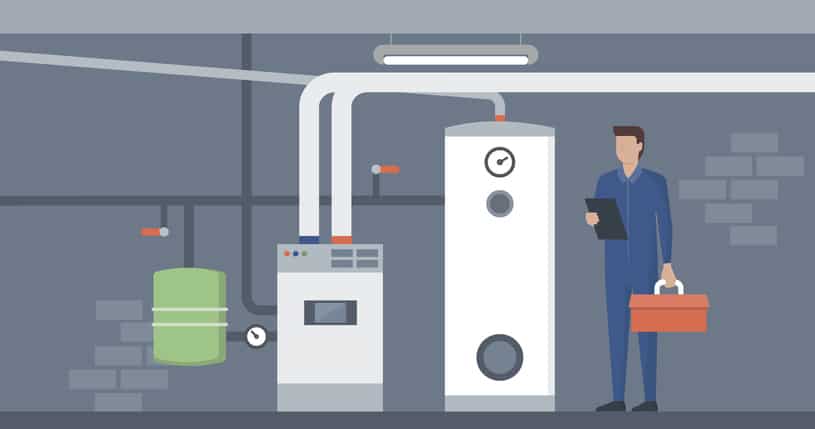
What Size Furnace Does Your Home Need?
Your furnace is probably something you only think about once a year when the HVAC system is getting its annual servicing. That is unless the furnace stops working. Suddenly you find yourself without heat and the furnace is the only thing on your mind.
A lot goes into furnace installation, use, and maintenance. One of the biggest factors is the size of your furnace. But how do you know if your furnace is the right size? This blog post will explain what factors go into calculating furnace size and why getting the right size is so important.
Why the Size of Your Furnace Matters
If you’ve never bought a furnace before then you may be surprised to find that there is a wide range of furnace sizes. It’s not the type of purchase where the correct size is specified for you. And simply guessing what will work best isn’t a good idea for a few reasons.
Cost
The size of the furnace not only affects the upfront cost but can also influence the monthly heating costs and longevity of the equipment. The more use you can get out of your furnace the longer you’ll go before you need to pay for a replacement.
Heating Efficiency
The size of your furnace is going to determine how efficiently your home is heated. A correctly sized furnace is going to use the minimum amount of energy compared to a furnace that’s too small or too large.
A furnace that is too small will have to work overtime, which can significantly increase energy use. Working harder than necessary will also strain the equipment, eventually leading to premature wear and tear.
But a furnace that’s too large can produce too much heat that goes to waste. Another problem with oversized heaters is that they can heat the home too quickly. On the surface this may seem like a good thing, however, it can overheat rooms that are closest to the furnace and cause short cycling. Short cycling is when the heater or air conditioner turns on and off after a short period because the home is heating up faster than it should.
How to Determine the Best Furnace Size
You know that furnace size is important, but how do you know which size is right? Below are some tips on how to figure out the best furnace size for your home and family’s needs.
Understand How Furnace Size is Measured
Furnaces don’t come in small, medium, and large sizes. The size is represented as BTUH capacity. BTUH stands for British thermal units per hour. The higher the BTUH is, the larger the furnace will be. Common furnace sizes include 80,000 BTUH, 100,000 BTUH and 120,000 BTUH. Furnace sizes are always going to be in 20,000 BTUH increments.
Calculate the Square Footage of the Home
Now you need to get an idea of how many British thermal units per hour your home requires. The first step in figuring that out is to calculate the square footage of your home. This will give you a rough estimate of heating needs in terms of space.
Know the Recommended Heating Factor
Next, you need to find the recommended heating factor. The heating factor for most homes is somewhere between 30 and 60 BTU per square foot. When in doubt check to see the recommended BTU for your region. The United States has five regions with BTU recommendations:
Zone 1 – 30-35 BTU per square foot (Miami, New Orleans, Houston)
Zone 2 – 35-40 BTU per square foot (Los Angeles, Atlanta, Little Rock)
Zone 3 – 40-45 BTU per square foot (Kansas, Missouri, Virginia)
Zone 4 – 45-50 BTU per square foot (Boston, Chicago, New York)
Zone 5 – 50-60 BTU per square foot (Minneapolis, Buffalo)
Essentially the farther you are from the equator the higher the BTU per square foot needs to be. Insulation and the number of windows in the home also affect the heating factor.
Multiply the Home Square Footage by Heating Factor
Now that you have the home’s square footage and heating factor recommendation you can calculate the BTUH that’s needed to adequately and efficiently heat your home. Let’s assume you have a 2,000 square foot home in Zone 3.
2,000 x 40 = 80,000
The calculation suggests that a furnace with a BTUH rating of 80,000 will meet your needs. However, to get the furnace size that works best there’s one more thing to consider.
Factor in the Efficiency Rating
The efficiency rating isn’t a measure of the amount of fuel or electricity a furnace uses. The efficiency rating refers to how well the furnace can produce a maximum BTUs per hour. For example, if a 100,000 BTUH furnace has an efficiency rating of 90% than means it actually produces 90,000 BTU an hour, not 100,000. When you factor in the efficiency rating you may find that you need to go up one size.
Make sure you’re getting a competitive rate on your gas usage by comparing plans at Spark Energy. We provide reliable, fixed-rate electricity and gas plans for millions of customers across the country. Check to see what energy plans are available in your area.



